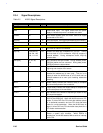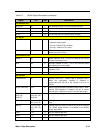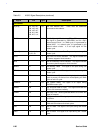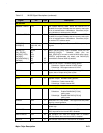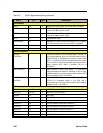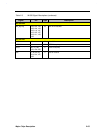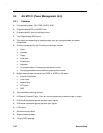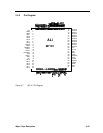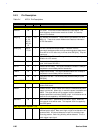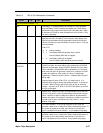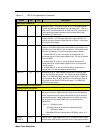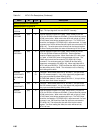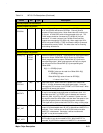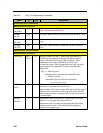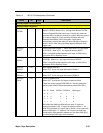
2-26 Service Guide
2.4.3 Pin Description
Table 2-4 M7101 Pin Descriptions
Name No. Type Description
PCI interface : (42)
PCICLK 89 I PCI Clock. This is the PCI Bus interface CLK input signal. This
clock frequency should not be more than 33 Mhz. It is used by
internal PCI interface.
AD[31:0] 91-98,2-
9, 20-
25, 27,
28, 30-
37
I/O PCI Address and Data bus. These lines are connected to PCI Bus’
AD[31:0]. These lines contain Address and Data bus information
for PCI transaction.
CBEJ[3:0] 99,10,
17,29
I PCI Bus Command and Byte enable. These are PCI bus
commands at address phase and byte enable signals at data phase.
Since M7101 is PCI slave only, it will not drive CBEJ[3:0]. They are
inputs only.
FRAMEJ 12 I Cycle FRAME for PCI bus. This signal indicates the beginning and
duration of a PCI access.
DEVSELJ 15 O Device select. When M7101 has decoded the address as its own
cycle, it will assert DEVSELJ.
IRDYJ 13 I Initiator Device Ready. This signal indicates the initiator is ready to
complete the current data phase of transaction.
TRDYJ 14 O Target Device Ready. This signal indicates that M7101 is ready to
complete the current data phase of transaction.
PAR 16 O Parity bit of PCI bus. It is the even parity bit across AD[31:0] and
CBEJ[3:0]
CLK & RESET interface : (3)
CLK32 62 I 32KHz clock. This is 32KHz clock input, used by internal timers and
relative PMU circuit.
PWGD 40 I POWER GOOD. When PWGD low means the VDD5&VDD3 power
supply is turned off. When high, it means the power is available and
stable. This signal will be sent to suspend circuit to disable the
suspend protected circuit when PWGD is high. It will also be sent to
reset the circuit supplied by VDD5&VDD3 power.
SUSRSTJ 39 I SUSPEND RESET. SUSPEND circuit RESET signal. When low,
the suspend circuit will be reset. The suspend circuit is supplied by
the VDDS power.
PMU Input event interface : (11)
ACPWR 49 I AC power. When plugged in or out, the AC adapter status will be
reflected at this signal. Both low to high or high to low transition will
generate SMIJ. An internal debounce is built-in to avoid the input
bouncing problem. Both rising & falling will be detected. This is a
smith-trigger input signal.



